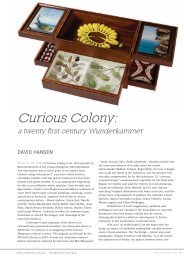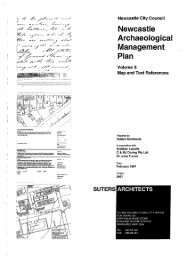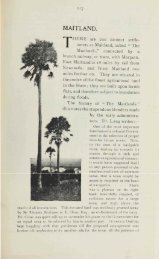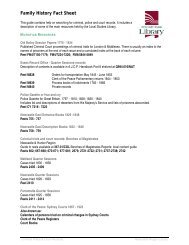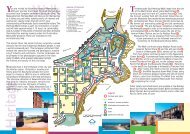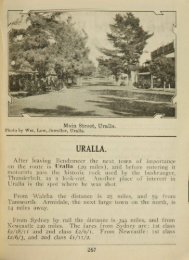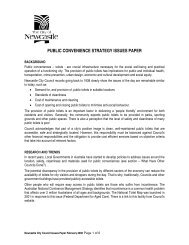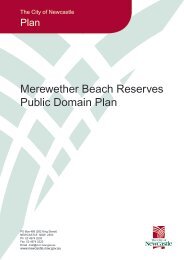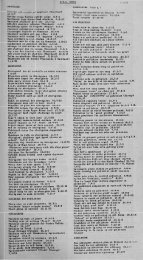Part Two – post 1920s - Newcastle City Council
Part Two – post 1920s - Newcastle City Council
Part Two – post 1920s - Newcastle City Council
You also want an ePaper? Increase the reach of your titles
YUMPU automatically turns print PDFs into web optimized ePapers that Google loves.
Intention to demolish more of the newly listed council owned Hunter Street facing<br />
buildings including the Clarendon Hotel provoked further protests. Demolition was<br />
seen as destroying a practical option for redevelopment, one that conserved the early<br />
20 th century design and scale of Hunter Street.<br />
Others believed that a cleared and vacant site was desirable. Commercial interests<br />
additionally favoured demolition of the buildings so that the land could be made<br />
available for car parking, pending the major development. 105 Lack of car parking in<br />
the CBD was said to be the biggest obstacle to the revitalisation of the city centre.<br />
Figure 48: buildings between the Clarendon Hotel and Burwood Street prior to demolition<br />
In the <strong>post</strong>-earthquake period <strong>Newcastle</strong> <strong>City</strong> <strong>Council</strong> was again in need of additional<br />
office space. The round design of the <strong>City</strong> Administration Building had proved less<br />
practical than more conventional offices designs. Some council owned buildings had<br />
sustained earthquake damage. Leased temporary office space in Hunter Street was<br />
expensive. Consideration was given to buying back Nesca House, and to buying<br />
another Darby Street property (the former Joint Coal board building) for a new office<br />
building. Converting the Fred c Ash building for office accommodation was an option<br />
discussed in 1991, although opposed by some councillors as a ‘waste of money’. 106<br />
Buying more property provoked the Secretary of Trades Hall <strong>Council</strong> to reproach the<br />
council for its apparent lack of an integrated strategic plan for the civic redevelopment<br />
and its own accommodation problems. The wisdom of buying even more buildings<br />
was questioned. (<strong>Council</strong> had already acquired 15 properties in the Civic block at a<br />
cost of over $11 million.) Adaptive reuse of the Fred c Ash building was said to be a<br />
practical plan. There were plenty of good examples of recycled warehouses in<br />
<strong>Newcastle</strong> converted into quality office space. 107<br />
105 <strong>Newcastle</strong> Herald 7 February 1990<br />
106 <strong>Newcastle</strong> Herald 18 June 1991<br />
107 <strong>Newcastle</strong> Herald 2 July 1991, letter from Peter Barrack Secretary <strong>Newcastle</strong> Trades Hall <strong>Council</strong><br />
<strong>Newcastle</strong> Civic and Cultural Precinct History ~ Cynthia Hunter ~ January 2003 page 62




